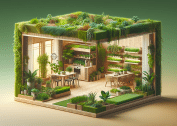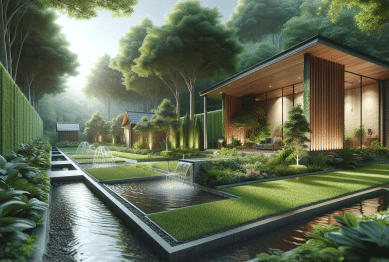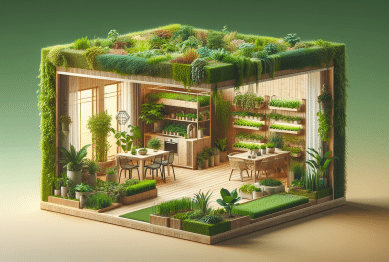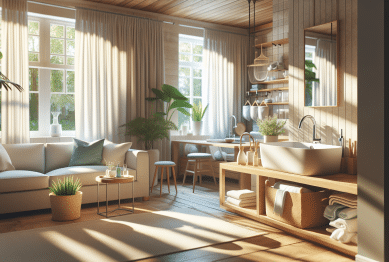Sustainable and functional living space is the new standard for home design in 2025. As climate concerns and urban density rise, these trends are becoming essential—not optional. Learn how cutting-edge designs can slash utility bills and help the planet.

Why Sustainability Is Non-Negotiable
The built environment contributes nearly 40% of global carbon emissions (World Green Building Council, 2023). As such, sustainable design is no longer a trend—it’s a responsibility. Homeowners and builders are now pivoting to solutions that minimize ecological impact while enhancing daily living in the living space.
1. Biophilic Design: Nature In Living Space
Biophilic design aims to reconnect humans with nature through architecture and interiors. Think sunlight, greenery, and organic textures. In 2025, this is not just about potted plants—it’s about creating a sensory experience that mirrors nature.
Key Features:
- Floor-to-ceiling windows for daylight
- Living green walls
- Natural materials like bamboo and cork
A study by the University of Exeter showed a 15% productivity boost in biophilic workspaces (Exeter University, 2022). Homes reap similar mental health benefits.
2. Recycled and Renewable Materials: Stylish and Smart
Gone are the days when sustainability meant bland aesthetics. Today’s sustainable materials are luxurious and cutting-edge.
Trending Materials:
- Reclaimed wood for flooring and furniture
- Recycled glass countertops
- Cork wall panels for insulation and soundproofing
Reclaimed hardwoods and recycled glass reduce the carbon footprint of manufacturing and save costs over time (U.S. Green Building Council, 2023).
3. Multifunctional Furniture: Smarter Spaces
As urban areas grow denser, square footage shrinks. Multifunctional furniture is now a staple for sustainable and functional living spaces.
Examples:
- Beds with storage drawers
- Desks that fold into walls
- Dining tables doubling as workstations
These pieces minimize clutter, reduce material usage, and allow homeowners to live big in small spaces (Wikipedia, 2025).
4. Smart Home Systems for Energy Control
Smart home systems are redefining how we consume energy. With automation, you can reduce waste without lifting a finger.
Top Systems:
- Smart thermostats like Nest or Ecobee
- Motion-sensor LED lighting
- Home energy dashboards
These technologies help users save up to 23% on heating and cooling annually (Energy Star, 2024). It’s a win for both your wallet and the environment.
5. Passive Design for Natural Light and Air
Why pay for lighting and air conditioning when nature can do the job? Passive design takes advantage of your local climate to heat, cool, and light your home.
Elements Include:
- Cross-ventilation architecture
- Skylights and solar tubes
- South-facing windows in cooler climates
The Passive House Institute states that homes built with passive principles consume up to 90% less energy for heating and cooling (Passive House Institute, 2023).
6. Water Efficiency That Works
Water shortages are no longer a distant threat. Your home should be ready now.
Smart Water Tips:
- Install dual-flush toilets
- Use rainwater tanks for gardens
- Incorporate xeriscaping (landscaping with minimal water use)
EPA estimates that water-efficient fixtures can save a household 20% annually on utility bills (EPA, 2023).
7. Insulation and Windows That Do More
Energy-efficient homes start with good insulation and smart windows.
Popular Choices in 2025:
- Spray foam or cellulose insulation
- Triple-pane windows with argon gas
- Reflective roofing materials
These upgrades may cost more upfront but pay back through savings in 3-5 years (Department of Energy, 2024).
8. Flexible Layouts for Changing Lifestyles
Modern life isn’t static. Your space shouldn’t be either. Flexibility in design allows one room to serve multiple purposes over time.
Popular Ideas:
- Partition walls that slide
- Built-in Murphy beds
- Modular furniture setups
Flexible layouts reduce the need for future renovations—saving materials, labor, and money.
9. Better Air Quality Through Design
Indoor air pollution is linked to respiratory issues and cognitive decline. Sustainable design also means healthier air.
Design Tips:
- Use non-toxic paint and adhesives
- Incorporate air-purifying houseplants
- Opt for mechanical ventilation systems like HRVs
Low-VOC materials are now industry standard and significantly improve indoor air quality (Environmental Protection Agency, 2024).
10. Local and Ethical Sourcing: Think Global, Buy Local
Sourcing local materials reduces the environmental cost of transportation and supports your community.
Look for:
- FSC-certified wood
- Local stone and clay
- Artisanal, handmade furniture
Buying local not only slashes emissions but supports ethical labor practices.
Final Thoughts
Designing a sustainable and functional living space isn’t about compromise—it’s about smarter choices. From biophilic design to smart tech, the trends of 2025 empower you to live better, save more, and help the planet. It’s not just about how a space looks—it’s about how it works for you and the world.
References:
- World Green Building Council (2023) Global Status Report for Buildings and Construction 2023. Available at: https://www.worldgbc.org (Accessed: 22 May 2025).
- U.S. Green Building Council (2023) Sustainable Materials Guide. Available at: https://www.usgbc.org (Accessed: 22 May 2025).
- Energy Star (2024) Smart Home Energy Saving. Available at: https://www.energystar.gov (Accessed: 22 May 2025).
- Passive House Institute (2023) What is Passive Design? Available at: https://www.passivehouse.com (Accessed: 22 May 2025).
- Environmental Protection Agency (2024) Indoor Air Quality Basics. Available at: https://www.epa.gov/indoor-air-quality-iaq (Accessed: 22 May 2025).









